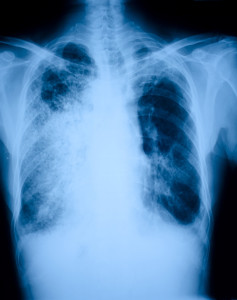When there is any suspicion of lung cancer a physician should be consulted immediately.
The physician will take a history, do a physical examination and listen to the lungs with a stethoscope. The physician looks for asymmetries of air-entry, presence of unusual sounds or labored breathing. A chest X-ray should be ordered and possibly some blood tests done. In this X-ray image the cancer was located in the right mid lung with a massive superimposed pneumonia. A referral to a respirologist (pulmonologist) should be made in high-risk persons (smoking history, industrial carcinogen exposure, and history of hereditary lung cancer).
The lung specialist likely will do a bronchoscopy (thanks to www.daviddarling.info for this image) on an outpatient basis. With this test the physician sprays the back of the mouth and the airways with a local anesthetic compound so that the patient has no problem to tolerate this procedure. A bronchoscopy is a procedure where the airways are probed with the introduction of a thin hose, which contains a channel with glass fibers for illumination and visual control, a suction channel to suction secretions and a channel for either a biopsy forceps or cautery. With this bronchoscope the skilled operator can obtain brushings, biopsies or stop bleeding. The specialist even can take photographs through the glass fiber channel and a video recording can be made with additional equipment.
Using flexible fiberoptic bronchoscopy the respirologist can also follow high-risk patients every year to do repeat brushings for early suspicious lesions. The pathologist uses the same classification methods as are used for Pap tests (the cell test for cervical cancer screening in women): normal, atypical, dysplastic cells, cancer in situ and overt cancer.
The key as in any cancer is to diagnose the lesions that are shortly before turning malignant and consist of atypical or dysplastic cells. At this stage of the development of lung cancer there are no symptoms, but if left alone and fed with carcinogenic gases they take off, invade and kill!
Remember: lung cancer is silent in the initial stages. This is why it is so important to screen early.
References
1. Cancer: Principles &Practice of Oncology, 4th edition, volume 1. Edited by V.T. De Vita,Jr.,et. al J.B. LippincottCo.,Philadelphia, 1993.Chapter on lung cancer.
2. Cancer: Principles&Practice of Oncology. 5th edition, volume 1. Edited by Vincent T. DeVita, Jr. et al. Lippincott-Raven Publ., Philadelphia,PA, 1997. Chapter on lung cancer.
3. The Merck Manual, 7th edition, by M. H. Beers et al., Whitehouse Station, N.J., 1999. Chapter 81: Tumors of the lung.
4. GW Krystal et al. Clin Cancer Res 2000 Aug;6(8):3319-3326.
5. BJ Druker et al. N Engl J Med 2001 Apr 5;344(14):1031-1037.
6. MJ Mauro et al. Curr Oncol Rep 2001 May;3(3):223-227.
7. Conn’s Current Therapy 2004, 56th ed., Copyright © 2004 Elsevier
8. Ferri: Ferri’s Clinical Advisor: Instant Diagnosis and Treatment, 2004 ed., Copyright © 2004 Mosby, Inc








